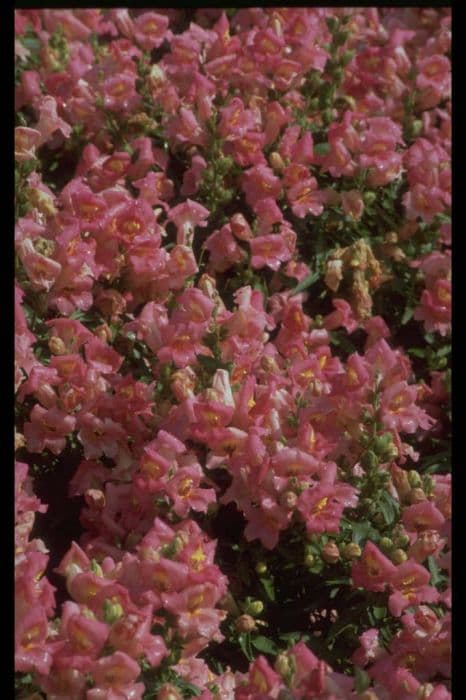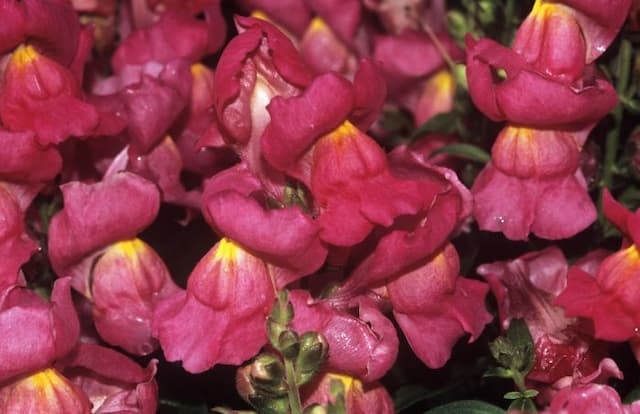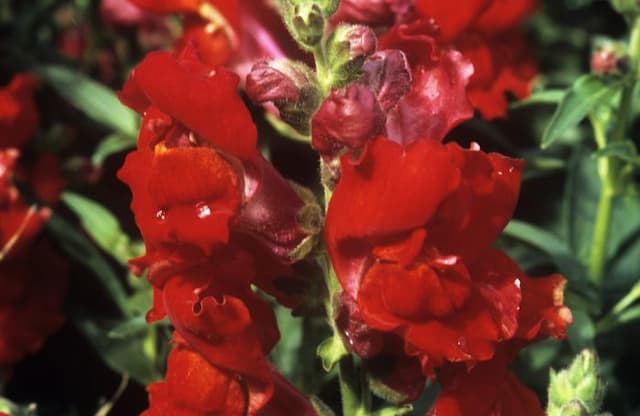Beardtongue Penstemon 'Pensham Marilyn' (Pensham Series)

ABOUT
The Penstemon 'Pensham Marilyn', commonly known as Beardtongue, is a striking perennial with a captivating appearance. It possesses lush, deep green foliage that provides a contrasting backdrop to its standout feature: the flowers. These blossoms are tubular in shape, with an alluring blend of pink and white shades that create a two-toned effect. The throats of the tubes often exhibit a paler color or can sometimes be white, inviting closer inspection. Flowers are clustered together atop sturdy stems, giving the impression of bountiful bouquets sprouting straight from the plant. These blooms are a magnet for pollinators such as bees and hummingbirds, adding a dynamic layer of activity to its aesthetic. The Penstemon 'Pensham Marilyn' exudes a cottage garden charm that can brighten up any garden space with its delightful floral display.
About this plant
 Names
NamesSynonyms
Beardtongue, Beard Tongue
Common names
Penstemon 'Pensham Marilyn'
 Toxicity
ToxicityTo humans
Penstemon 'Pensham Marilyn', commonly known as Beardtongue, is not known to be toxic to humans. In general, Penstemons are considered safe and do not usually cause adverse reactions if ingested in small quantities. However, it is always advisable to avoid eating ornamental plants, as they are not intended for consumption and their effects can vary from person to person.
To pets
Beardtongue is also not known to be toxic to pets. These plants are generally considered non-toxic to dogs and cats. As with humans, it is still best to prevent pets from ingesting ornamental plants, since they are not a part of their natural diet and can potentially cause gastrointestinal upset or other issues if consumed in large quantities.
 Characteristics
CharacteristicsLife cycle
Perennials
Foliage type
Deciduous
Color of leaves
Green
Flower color
Pink
Height
2-3 feet (60-90 cm)
Spread
2 feet (60 cm)
Plant type
Herb
Hardiness zones
5
Native area
North America
Benefits
 General Benefits
General Benefits- Attracts Pollinators: Penstemon 'Pensham Marilyn' is known for attracting bees and butterflies, essential pollinators for a healthy garden ecosystem.
- Long Blooming: This variety typically offers a long flowering season, providing color and interest in the garden for an extended period.
- Drought Tolerant: Once established, Penstemon 'Pensham Marilyn' has low water needs, making it suitable for xeriscaping and drought-prone areas.
- Low Maintenance: It requires minimal care, making it ideal for gardeners looking for plants that do not need constant attention.
- Cold Hardy: This plant is known for being hardy in cooler temperatures, which can make it a staple in gardens with harsher climates.
- Versatility: Suitable for borders, rock gardens, and containers, it offers flexibility in garden design and placement.
- Deer and Rabbit Resistant: This characteristic can be beneficial in areas where wildlife browsing is a concern for gardeners.
- Vibrant Color: Offers vivid floral displays that can brighten up any garden space.
- Cultural Significance: Often used in cottage gardens and traditional plantings, it can contribute to a garden's thematic aesthetics.
- Suitable for Cutting: The flowers are suitable for cutting and using in floral arrangements, adding an additional use beyond garden aesthetics.
 Medical Properties
Medical PropertiesThis plant is not used for medical purposes.
 Air-purifying Qualities
Air-purifying QualitiesThis plant is not specifically known for air purifying qualities.
 Other Uses
Other Uses- Artistic expression: The striking blooms of Penstemon can be used as natural paint brushes for a unique form of botanical art.
- Photography subject: With their vivid colors, they're often used by photographers to create stunning macro photography subjects.
- Educational tool: Penstemon can serve as an excellent specimen in botanical studies to educate about plant morphology and pollination.
- Culinary decoration: The flowers can be used to decorate cakes and pastries for a natural, edible embellishment.
- Dye production: The petals of Penstemon can be used as a source of natural dyes for fabrics or papers.
- Horticultural competitions: Gardeners often use Penstemon plants to enter into flower shows for their aesthetic appeal and variety.
- Insect habitat: These plants can be deliberately grown to create habitats for beneficial garden insects, such as bees and butterflies.
- Eco-friendly confetti: Dried petals of Penstemon can be used as a biodegradable confetti alternative for celebrations.
- Marker of seasonal change: In a garden, Penstemon blooms can be used to indicate the onset of summer for phenological observations.
- Nature crafts: Dried Penstemon flowers can be incorporated into wreaths, pressed flower arrangements, and other botanical crafts.
Interesting Facts
 Feng Shui
Feng ShuiThe Beardtongue is not used in Feng Shui practice.
 Zodiac Sign Compitability
Zodiac Sign CompitabilityThe Beardtongue is not used in astrology practice.
 Plant Symbolism
Plant Symbolism- Versatility: Penstemons are known for their wide variety and adaptability to different growing conditions, symbolizing versatility and the ability to thrive in various environments.
- Attraction: With their vivid flowers, they are a beacon for hummingbirds and butterflies, symbolizing attraction and the beauty that draws others in.
- Endurance: As perennials, they symbolize endurance and long-lasting presence, returning year after year.
- Healing: Some Native American tribes used Penstemons for their medicinal properties, hence they can symbolize healing and curative powers.
- Diversity: The wide range of cultivars and colors in Penstemons symbolize diversity and the celebration of differences.
 Water
WaterBeardtongue should be watered deeply but infrequently, aiming for about 1 inch of water per week. This ensures that the soil has a chance to dry out between waterings, which helps to prevent root rot. During the active growth period in spring and summer, watering may be required every 5 to 7 days, especially in hotter, drier climates. Reduce watering in the fall and water sparingly in winter, adjusting for rain and snow that provides natural moisture. It is best to water the plant at the base, avoiding wetting the foliage, which can lead to fungal diseases.
 Light
LightBeardtongue thrives in full sun, meaning at least 6 to 8 hours of direct sunlight daily. The ideal spot for this plant would be an unobstructed south-facing or west-facing location where it can receive ample sunlight to promote healthy growth and abundant flowering. However, in extremely hot climates, a location with afternoon shade can help protect the plant from scorching.
 Temperature
TemperatureBeardtongue does well in a wide range of temperatures, but it prefers a moderate climate. It can tolerate minimum temperatures down to around 20 degrees Fahrenheit but will not survive prolonged periods of extreme cold. The ideal temperature range for this plant is between 60 and 75 degrees Fahrenheit, which encourages vigorous growth and flowering.
 Pruning
PruningBeardtongue benefits from pruning to promote bushier growth and more flowers. Deadheading spent blooms throughout the season encourages the plant to produce more flowers. In late winter or early spring, before new growth begins, cut back the plant by about one third to help rejuvenate it and maintain a tidy shape.
 Cleaning
CleaningAs needed
 Soil
SoilBeardtongue (Penstemon) 'Pensham Marilyn' thrives in well-drained, loamy to sandy soil with a neutral to slightly alkaline pH, ideally ranging from 6.5 to 8. For the best soil mix, blend equal parts of garden soil, sand, and compost to promote good drainage and provide essential nutrients.
 Repotting
RepottingBeardtongue plants do not need frequent repotting and can often remain in the same pot for several years. However, if the plant outgrows its container or the soil becomes compacted, it's best to repot it in the spring or early summer.
 Humidity & Misting
Humidity & MistingBeardtongue plants are adaptable to a wide range of humidity levels and do not require any specific humidity conditions to thrive. They are tolerant of dry air and can grow well in the average humidity found in most outdoor environments.
 Suitable locations
Suitable locationsIndoor
Place in bright, indirect light and ensure good air circulation.
Outdoor
Full sun to partial shade, shelter from strong winds.
Hardiness zone
7-9 USDA
 Life cycle
Life cycleThe life cycle of Penstemon 'Pensham Marilyn' begins with seed germination, which occurs in moist, well-drained soil in a sunny or partly shaded area, typically in the spring. After sprouting, the seedlings grow into young plants, developing a rosette of leaves at the base. As the plant matures, it produces sturdy stems and an abundance of bell-shaped flowers in shades of pink and purple during the summer months, attracting pollinators like bees and hummingbirds. After flowering, the plant sets seed which can be collected or left to self-sow, completing the reproductive cycle. Throughout the growing season, the plant experiences vegetative growth, creating a fuller clump with increased foliage and stems. With the onset of winter, the plant dies back, with the roots remaining dormant until the next spring when the lifecycle starts anew.
 Propogation
PropogationPropogation time
Spring-Early Summer
The most popular way to propagate Penstemon 'Pensham Marilyn' is by taking stem cuttings. This should ideally be done in early to mid-summer to allow cuttings to root before the cooler weather sets in. Cuttings should be taken from new growth that has not yet flowered. Cut a 3 to 4 inch (approximately 7.5 to 10 cm) section from the tip of a healthy stem, removing the lower leaves to expose a clean section of stem. The cut end can then be dipped in rooting hormone to encourage root growth, though this is not always necessary. The prepared cutting should be placed in a well-draining potting mix, with the leafless part buried. It must be kept in a warm, lightly shaded spot and the soil should be kept consistently moist but not waterlogged to promote rooting, which can take several weeks.









